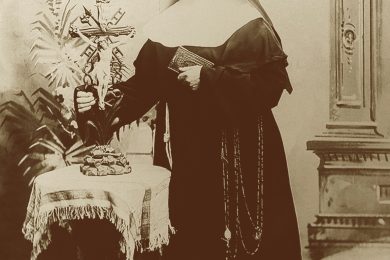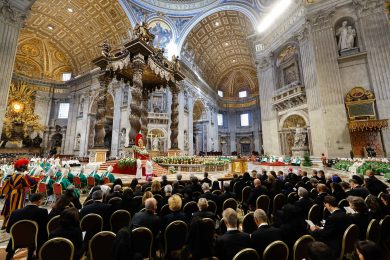When an individual or secularized culture has largely abandoned faith, the Virgin Mary often lingers in grace-filled whispers. Take the “Hail Mary pass” in football, or the lovely musical renditions of the “Ave Maria,” both of which remain popular in secular society today. As the Cathedral of Notre Dame in Paris burned in 2019, strains of the hauntingly beautiful Hail Mary in French were sung by bystanders as firefighters battled the flames.

Like the frightened young communist soldier whose repetition of party rhetoric shifts to a “Hail Mary” when faced with death in Ernest Hemingway’s “For Whom the Bell Tolls,” we are called back by our Heavenly Mother amid our troubles in this valley of tears even when we think we have cast off faith.
As I revisit one spiritual classic a month this year, I thought it only fitting to take up a spiritual classic devoted to Mary in the month of May. Coming with the recommendations of eight popes, “True Devotion to Mary” by St. Louis-Marie de Montfort was an obvious choice to explore the devotion to Our Lady of whom, de Montfort notes, “there is scarcely a sinner, who even in his obduracy, has not some spark of confidence in her.”
Originally written in the beginning of the 18th century, de Montfort’s work gained enormous popularity after it was rediscovered and published in 1843. The treatise and its companion consecration prayers outline how devotion to Mary is a sure path to her son.
“God the Father has not given his Only-Begotten to the world except by Mary,” de Montfort wrote. “How highly we glorify God, when, to please Him, we submit ourselves to Mary, after the example of Jesus Christ, our Sole Exemplar!”
He wrote that while Mary is “infinitely below her Son, who is God, and therefore she does not command Him as a mother here below would command her child, who is below her,” nevertheless, God “never resists the prayer of His dear Mother, because she is always humble and conformed to His Will.”
Her humility and conformity to the will of God, evident in her “yes” to His plan of salvation, provide a great model for us in surrendering ourselves to the will of God.
De Montfort saw devotion to Mary as a necessary part of Christian life and wrote that while Mary is “necessary to God by a necessity which we call hypothetical, in consequence of His Will, she is far more necessary to men, in order for them to arrive at their Last End.”
He grounded much of his writing on Mary in the teachings of the church fathers and cited St. John Damascene’s writing that “to be devout to you, O holy Virgin, is an arm of salvation which God gives to those whom He wishes to save.”
He also referenced St. Bonaventure’s writing that “the way to come to Christ is to approach her: he who shall fly her shall not find the way of Peace.”
To those who might fear to draw near to Mary lest it detract from her son, de Montfort offered reassurance.
“Our Blessed Lady is the means Our Lord made use of to come to us. She is also the means which we must make use of to go to Him,” he wrote. “For she is not like all the rest of creatures, who if we should attach ourselves to them, might rather draw us away from God than draw us near Him. The strongest inclination of Mary is to unite us to Jesus Christ her Son; and the strongest inclination of the Son is that we should come to Him by His holy Mother.”
De Montfort called Mary “the mediatrix of intercession” to Jesus who is our Mediator before God. Citing St. Bernard of Clairvaux who called her the “mediator of salvation,” he wrote that “we have need of a mediator with the Mediator Himself,” and Mary is uniquely suited for such a role.
“In seeing her, we see our pure nature,” he explained, “she is not the sun, who, by the vivacity of his rays, blinds us because of our weakness; but she is fair and gentle as the moon, which receives the light of the sun, and tempers it to render it more suitable to our capacity.”
He also reflected on how God “did not will to come into the world at the age of a perfect man, independent of others, but like a poor and little babe, dependent on the cares and nourishment of this holy Mother” and how the Lord remained under her care for 30 years.
“Are we so senseless as to imagine that we can find a more perfect or a shorter means of glorifying God than that of submitting ourselves to Mary after the example of her Son,” he asked.
For those devoted to Mary, de Montfort wrote that she will instill in them a portion of her great faith in God and she will “take away from your heart all scruple and all disorder of servile fear” and “introduce into it pure love, of which she has the treasure; so that you shall no longer be guided by fear.”
St. Pope John Paul II took his papal motto “Totus tuus” or “all yours” from de Montfort’s words, “I am all yours, and all that I have is yours, O most loving Jesus, through Mary, your most holy Mother.”
In a 2004 letter to the Montfort religious family, Pope John Paul II emphasized the great influence de Montfort’s work had on his own Marian spirituality and reflected on Christ’s words on the cross to the beloved apostle John, “Behold your Mother.”
“Throughout its history, the People of God has experienced this gift of the crucified Jesus: the gift of his Mother,” he wrote. “Mary Most Holy is truly our Mother who accompanies us on our pilgrimage of faith, hope and charity towards an ever more intense union with Christ, the one Saviour and Mediator of salvation.”
– – –
Lauretta Brown is culture editor for OSV News. Follow her on X (formerly Twitter) @LaurettaBrown6.






















